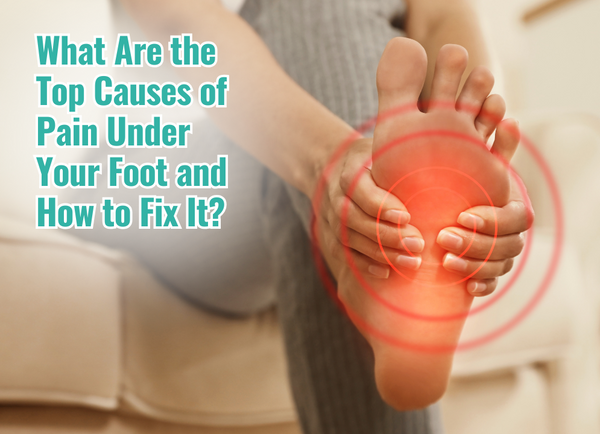What Are the Top Causes of Pain Under Your Foot and How to Fix It?
Mar 25, 2025
Have you ever felt that annoying foot pain that makes every step awful? Foot pain is fairly common, and it can really ruin your day—running, on your feet all day at work, or just trying to go for a walk. The good news? Most foot pain is caused by something, and once you know what's happening, you can do something about it. Foot pain affects affects millions of people worldwide, turning simple actions like walking, standing, or simply resting into a chore. It's a common problem that requires fixing.
According to the American Podiatric Medical Association (APMA), approximately 77% of adults experience foot pain at some point in their lives, yet only a third seek treatment. Understanding the root causes and applying effective solutions can make a significant difference in foot health.

Let’s dive into the top causes of foot pain and how you can finally find relief!
1. Plantar Fasciitis
If your heel and arch ache in the morning when you step out for the first time as if they're being stabbed, plantar fasciitis might be the reason.
A study in the National Library of Medicine found that plantar fasciitis affects approximately 10% of the general population, with 83% of affected patients belonging to the working age group of 25 to 65 years. The incidence rates among runners are as high as 22% according to some sources.
How to fix it:
- Stretch your calves and arches every day.
- Wear supportive shoes with good arch support.
- Try a deep-kneading foot massager to relieve tension.
2. Flat Feet
Got little or no arch when you walk? Flat feet can cause extra stress on your muscles and ligaments, leading to pain.
A study in Foot & Ankle International found that individuals with flat feet have a significantly higher risk of foot pain due to improper weight distribution.
How to fix it:
- Use orthotic insoles for better arch support.
- Make your foot muscles stronger with exercises such as toe curls.
- Wear properly fitting shoes that offer support.
3. Heel Spurs
Heel pain that's like walking on a small pebble? That might be a heel spur, a bony growth due to repetitive stress.
How to fix it:
- Cushion your heels with gel inserts.
- Stretch your plantar fascia and Achilles tendon.
- Use a heated foot massager to relax tight muscles.
4. Morton’s Neuroma
Feeling like there’s a pebble stuck in your shoe even when there’s nothing there? Morton's neuroma is when nerves in your foot become thickened and inflamed.
A study in The Journal of Foot and Ankle Research found that tight-fitting shoes and high-impact activities significantly increase the risk of developing Morton’s neuroma.
How to fix it:
- Wear wider shoes to prevent compressing your toes.
- Use metatarsal pads for extra cushioning.
- Try physical therapy for long-term relief.
5. Metatarsalgia
Pain and inflammation in the ball of your foot? This condition is common among runners and people who wear high heels often.
How to fix it:
- Rest your feet and avoid excessive pressure.
- Use shock-absorbing insoles.
- Switch to supportive, cushioned shoes
6. Stress Fractures
If your foot pain started after increased activity or repetitive impact, you might have a tiny crack in one of your foot bones
How to fix it:
- Give your feet a break (yes, rest is the key!).
- Wear proper footwear for impact activities.
- Strengthen bones with a diet rich in calcium and vitamin D.
7. Tarsal Tunnel Syndrome
Numbness, burning, or tingling pain in your foot? You could have a pinched nerve in your ankle.
How to fix it:
- Wear supportive footwear that has arch support.
- Reduce inflammation with ice and elevation.
- Try physical therapy to improve foot mobility.
8. Peripheral Neuropathy
Numbness, burning, or tingling in your feet? It could be due to diabetes, nerve damage, or vitamin deficiency.
It is estimated that more than 20 million Americans have peripheral neuropathy, according to the National Institute of Neurological Disorders and Stroke.
How to fix it:
- Control underlying health conditions.
- Maintain your feet well moisturized and use protective shoes.
- Use gentle massagers to improve circulation and reduce discomfort.
9. Gout
Sudden, intense pain in your foot (especially at night)? Gout is a type of arthritis caused by excess uric acid in the blood.
How to fix it:
- Stay hydrated and reduce high-purine foods (like red meat and alcohol).
- Take anti-inflammatory medications as needed.
- Elevate your foot to reduce swelling.
✅ Do’s:
- Wear comfortable, well-cushioned shoes.
- Stretch and strengthen your foot muscles regularly.
- Use ice packs to reduce swelling and inflammation.
- Maintain a healthy weight to minimize pressure on your feet.
- Consider using a foot massager for targeted relief.
❌ Don’ts:
- Ignore persistent foot pain—consult a specialist if it doesn’t improve.
- Walk barefoot on hard surfaces for prolonged periods.
- Wear high heels or tight-fitting shoes daily.
- Overlook signs of infections, cuts, or sores on your feet.
- Self-diagnose serious foot conditions—always seek professional advice.
Conclusion
Foot pain doesn't have to hold you back! Determining the cause is the key to relief. Easy lifestyle changes—such as stretching, proper footwear, and massage therapy—can make a difference.

If you require quick and effective relief, turn to Nekteck's foot massagers for deep relaxation, targeted pain relief, and improved blood circulation. Its deep-kneading massage can possibly ease aching muscles and calm tension after a long day at work. Your feet will appreciate it!

